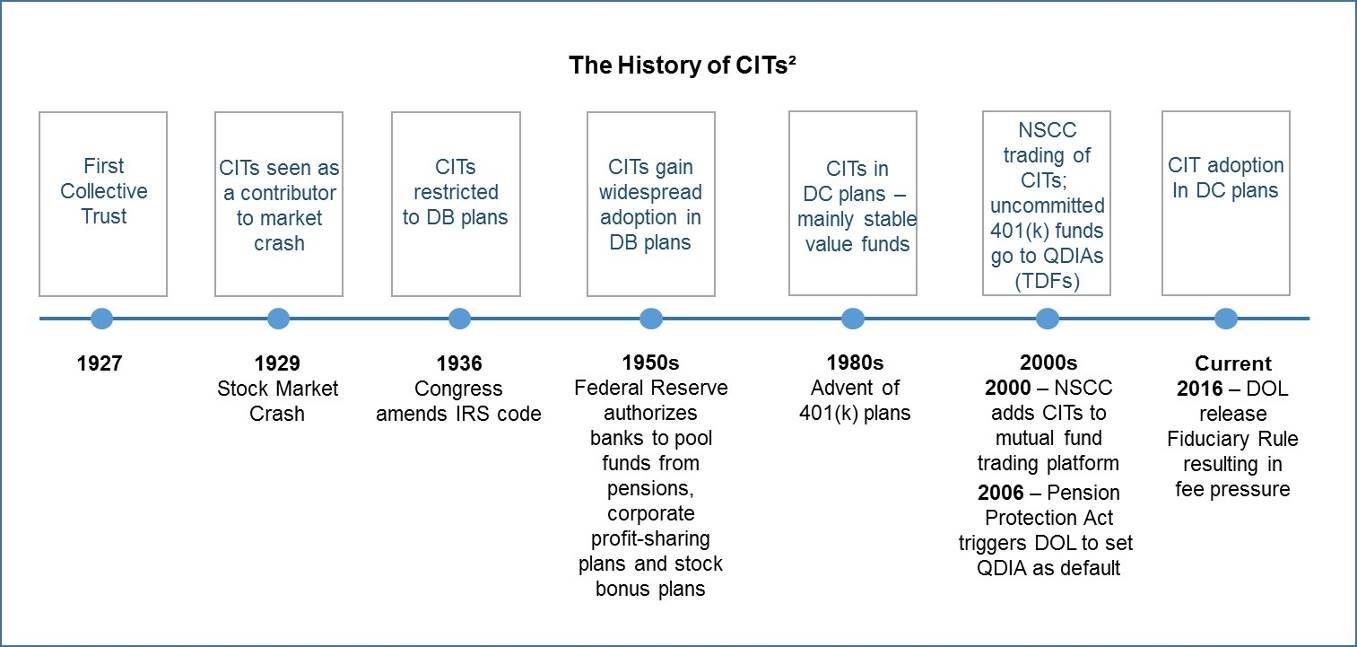
The Financial Wellness Pandemic
July 7, 2020
Summer Homework for Fiduciaries
July 26, 2020For almost a century, collective investment trusts (CITs) have played an important role in the markets. They were originally introduced in 1927. According to a 2020 study, they are now used in more than 70 percent of plans.¹
For the vast majority of their existence, CITs were available only in defined benefit (DB) plans. In 1936, CIT use expanded in DB plans when Congress amended the Internal Revenue Code to provide tax-exempt (deferred) status to CITs. CITs then gained widespread adoption in the 1950s when the Federal Reserve authorized banks to pool together funds from pensions, corporate profit-sharing plans and stock bonus plans. The IRS also granted these plans tax-exempt status.
In the 1980s, 401(k) plans became primary retirement plans and mutual funds became the primary investment vehicle, due to daily valuation. In the 2000s, CITs gained significant traction in defined contribution (DC) plans due to increased ease of use, daily valuation, and availability. During this time, CITs were also named as a type of investment that qualifies as a qualified default investment alternative (QDIA) under the Pension Protection Act of 2006.
From 2011 to 2018, total assets in CITs grew by approximately 64 percent. During which their share of 401(k) assets reached nearly 28 percent, or approximately $1.5 trillion.2
The advantages of CITs are plentiful:
• Lower operational and marketing expenses
• A more controlled trading structure compared to mutual funds
• They’re exempt from registration with SEC, thereby avoiding costly registration fees
On the other hand, CITs are only available to qualified retirement plans and they may have higher minimum investment requirements.
While CITs have traditionally only been available to large and mega-sized plans, continued fee litigation – as well as increased CIT transparency, reporting capabilities and enhanced awareness – has amplified the allure of CITs to plan sponsors across all plan sizes. However, CITs have not been widely available to all plans — until now.
Through your advisor’s strategic partnership with RPAG, a national alliance of advisors with over 60,000 plans and $600 billion in retirement plan assets collectively⁴, they can provide their clients with exclusive access to actively managed, passively managed and target date CITs, featuring top-tier asset managers⁵ at a substantially reduced cost.
For more information on CITs, please contact your Duncan Financial Group plan advisor.
¹Callan-2020-DC-Trends-Survey
²Collective Investment Trusts: An Important Piece in the retirement Planning Puzzle-Wilmington Trust-2020
³DST kasina with data from Department of Labor, Investment Company Institute.
⁴As of 1/1/2020.
⁵Top-tier asset managers include BlackRock, Franklin Templeton and Lord Abbett.
The target date is the approximate date when investors plan on withdrawing their money. Generally, the asset allocation of each fund will change on an annual basis with the asset allocation becoming more conservative as the fund nears target retirement date. The principal value of the funds is not guaranteed at any time including at and after the target date.
Collective investment trusts available only to qualified plans and governmental 457(b) plans. They are not mutual funds and are not registered with the Securities and Exchange Commission.
About the Author, Alex Kahn
Alex is an investment analyst for RPAG. He consults top-tier advisors and plan sponsors across the country on investment due diligence, with a focus on target date funds. He provides pragmatic insight on market trends and developments. Alex is also an international equity analyst for the RPAG Investment Committee and advises clients on this custom target date solution. Alex graduated with a Bachelor of Arts in economics from the Wharton School of Business at the University of Pennsylvania.





